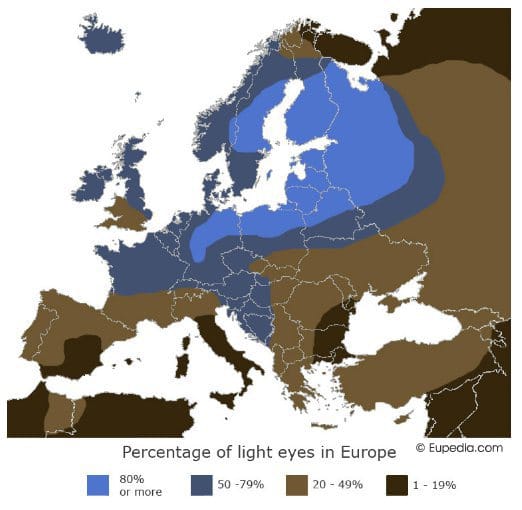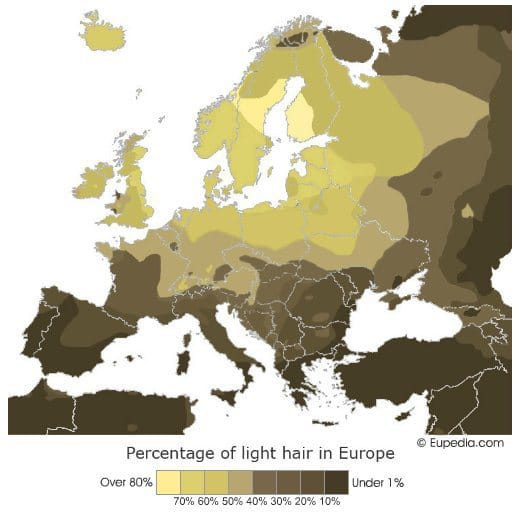Before the Viking Age, the Northerners had 13,000 years of history in Scandinavia. The early history of the Nordic region is now being rewritten when new facts from modern research are added.
Scientific technologies such as modern DNA technology, carbon-14 dating, chemical isotope analyses of metals, and modern computer-aided linguistic research combined with recent archaeological finds give a completely new picture of Nordic history than previously taught.
The history of the Nordic countries is much older and more advanced than previously thought. An image emerges that the entire Nordic region, up to the north, was inhabited more than 10,000 years ago. Maps of the extent of the ice sheet over the millennia may be redrawn. It is now known through DNA research that the characteristics of the northerners with various variants with fair skin, blonde hair, and blue eyes arose 11,000 years ago.
Read more about the study here.
DNA technology shows that the indigenous peoples of Europe had blue eyes and fair hair.
The Northerners are the indigenous people of the Nordic countries and are the ones who have inhabited the Nordic countries since time immemorial. Probably already 35,000 years ago, during the time known as the Jämtland Interstadial, when the north was ice-free to the north of Jämtland. This was thousands of years before the ice age peaked 22,000 years ago.

Modern DNA research shows that the Nordic peoples are the indigenous peoples of the Nordic countries and Europe’s oldest and first indigenous people. The Northerners were the first to populate Europe. The original northerners belong to the male haplogroup I *, the only haplogroup to emerge in Europe. Unfortunately, haplogroup I * and its migrations are not as mapped as the Indo-European haplogroups R1a * and R1b *. Hopefully, the knowledge gaps for the Old Norse haplogroup will be filled in the next few years.

The images show the dominant haplogroups for different areas in Europe. The blue areas show the haplogroups I, I1 *, and I2 *, the first northerners. The red region offers haplogroup R1b * in Western Europe and the orange haplogroup R1a * in Eastern Europe. These haplogroups immigrated to Europe about 4800 years ago. The yellow areas show haplogroup N *, to which the original Finns and Sami arrived in the north about 3000 years ago.
Scandinavians are the first Europeans, according to DNA from a 37,000-year-old skeleton.
An international team of researchers has examined the genome of the k14 skeleton, a 37,000-year-old male body found in Kostenki, Russia. The man’s Y-DNA was haplogroup C-M130 and had 1% more Neanderthal DNA than modern humans have. From a genetic point of view, the man is a European, says Professor Eske Willerslev, head of the Center for GeoGenetics at the University of Copenhagen, who was involved in the new study.
The study shows that Scandinavians – i.e., Norwegians and Swedes – are more closely related to the Kostenki man than living people. This means that Scandinavians are the first Europeans. The discovery and dating also show that northerners inhabited northern Europe during the warm period, 15,000 years before the ice age peaked.
The history of the Nordic countries is much older and more advanced than previously thought. New scientific technologies such as modern DNA technology, carbon-14 dating, chemical isotope analyses of metals, and modern computer-aided linguistic research combined with recent archaeological finds give a completely new picture of Nordic history than previously taught.
An image emerges that the entire Nordic region, up to the north, was inhabited more than 10,000 years ago. Maps of the extent of the ice sheet over the millennia may be redrawn. It is now known through DNA research that the characteristics of the northerners with various variants with fair skin, blonde hair, and blue eyes arose 11,000 years ago.
Blond hair and blue eyes originated in the north 11000 years ago.
The Northerners have always been tall, blue-eyed, and fair-haired. Nordic appearance with light or blonde hair and blue eyes arises, among other things, from a mutation in the MC1R gene, probably in central Sweden. According to researchers at three Japanese universities, the world-leading DNA researcher Hans Eiberg at the University of Copenhagen identified the transformation in the HERC2 / OCA2 genes for blue eyes and fair skin in 2008.
The researchers state that traits such as fair skin, blue eyes, and light hair arose through gene mutations in Nordic countries more than 11,000 years ago. The dating of the transformation has been isolated to about 11,000 years ago.
The images below show the distribution and proportion of the population with blonde hair and blue eyes in Europe instead of brown and dark hair. Central Sweden and eastern Finland are where the most significant proportion of the population has blonde hair and blue eyes.
The distribution maps show that the highest frequency of light hair and blue eyes is found in central Norrland. So the neighborhoods have been inhabited since time immemorial. Nämforsen in Ångermanälven has about 2600 rock carvings dating back 6000 years ago.


The causes of the mutations for fair skin and blue eyes.
Fair skin with a small amount of pigment melanin has a sun factor of 3, and just over 20 minutes of sunshine on a high summer day gives 250 micrograms of Vitamin D, compared to a pill that offers about ten micrograms. The Nordic region’s light, harsh and cold climate contributed to these genetic changes, which meant light skin, blonde hair, and blue eyes.
Those who do not have fair skin in the Nordic climate will have vitamin D deficiency to the lack of sunshine. Dark skin sun protection corresponds to sun factor 13 and requires about ten times as much light as the climate in the north can produce to get the same amount of vitamin D as light skin. The incidence of skin cancer is about ten times as high in fair-skinned people compared to dark-skinned people, so northerners are not made for solid sunlight in sunny countries.
Large-scale mapping of Ancient DNA.
In 2015, Harvard University conducted an extensive study of 69 finds with ancient DNA, and the University of Copenhagen surveyed 101 finds of ancient DNA. Among other things, they examined the DNA of seven people from a 7,700-year-old site in Motala. The men belonged to the male haplogroup I2 *. They had both variants for the light complexion, SLC24A5, and SLC45A2. But they also had a third gene, HERC2 / OCA2, which causes blue eyes and contributes to pale skin and blonde hair.
When the northerners had fair skin and blue eyes, the population in the rest of Europe had dark skin and brown eyes. Later Indo-European immigration from the Yamnaya culture in the east, which started 4,800 years ago, had light skin, but all had brown eyes.
Today, more than 300 million people have these genetic predispositions with fair skin, blue eyes, and blonde hair.

